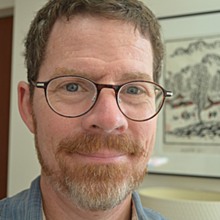
 Tobias Higbie is an Associate Professor in the UCLA Department of History who teaches classes on U.S. History, labor and social movement history, labor studies, and digital humanities/history. Higbie previously served as the director of a research center at the Newberry Library in Chicago.
Tobias Higbie is an Associate Professor in the UCLA Department of History who teaches classes on U.S. History, labor and social movement history, labor studies, and digital humanities/history. Higbie previously served as the director of a research center at the Newberry Library in Chicago.
Higbie’s diverse interests lead him to carry out his own interdisciplinary research in which he uses technology to digitize historical records.
“It is detrimental to get caught up in one’s own discipline, since good ideas are all around us,” said Higbie. As a labor historian, he is interdisciplinary by default. He recently finished a digital history project that converted a century-old book, titled the American Labor Who’s Who, into a research and teaching database.
With historians, this is quite often the case – interdisciplinary work allows for the integration of new methods, ideas, and thoughts about documenting the past.
“We’re eclectic and our toolbox can be varied,” he said.
Higbie’s work is not so much a digital research project as it is a digital presentation of historical records. By organizing the data in this fashion, he is able to easily comprehend the data and unravel the complexities and hidden relationships of one of the most important social movements in U.S. History.
The American Labor Who’s Who is a directory of activists in the fields of trade unionism, immigrant rights, civil liberties, cooperatives, progressive and radical politics. It was originally published in 1925, an especially contentious moment in labor history.
In print, the book is like many other out-of-date directories that have suffered lonely lives on dusty library shelves, but since it has been digitized, it has become an invaluable source of information for Higbie and many other researchers.
After digitizing the book, Higbie, with the aid of his colleagues from the UCLA Library and Center for Digital Humanities, converted the digitized text into a database. From this database, he has come to some remarkable conclusions about the nature of the labor movement.
He began to understand labor history not as labor parties and trade unions but as relationships between people and organizations. To visualize this concept, he utilized network graphing. Later he came to realize that the visualizations themselves are abstractions that are quite difficult to communicate, which is one of the challenges he faces in his research.
“Through network analysis, you can make some interesting discoveries about the contours of the social formation that we call the labor movement,” he said.
By building network charts from the database, Higbie can see which people were involved in both trade unionism and the political labor movement. He can also begin to understand the world of fraternal organizations, such as The Masons and The Knights of Pythias, which were important social networks during the early 20th century.
Higbie asked his students to examine the database from American Labor Who’s Who and construct a story from the data. By engaging his students in this type of task, Higbie aimed to help them develop the ability to quantify and visualize data. For Higbie, these are crucial skills historians must possess.
Many people are attracted to the field of history, according to Higbie, “because they don’t like numbers, but if you don’t have a basic understanding of charts and figures, it’s easy to be lied to.”
In the future, Higbie hopes to use the data he has collected on labor history and incorporate it into Google Maps. This information can then be used to create historical walking tours of urban areas.
Being a part of the IDRE HASIS Committee has been really helpful for Higbie in connecting to additional resources to launch his digitization projects and understanding the lay of the land technologically.
Higbie ultimately hopes to encourage other historians to pursue interdisciplinary work and engage with digital humanities. “Since historians have a very useful perspective of a critical eye and have a long chronological sense of how things change and stay the same, it is important that historians be more engaged with digital publishing,” he said.